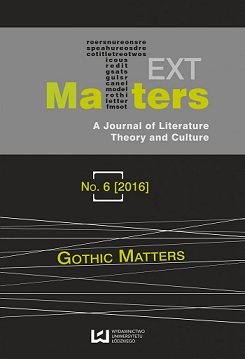Mary Shelley’s Frankenstein, the Guillotine, and Modern Ontological Anxiety
DOI:
https://doi.org/10.1515/texmat-2016-0003Abstract
This essay begins by examining the rhetorical significance of the guillotine, an important symbol during the Romantic Period. Lacefield argues that the guillotine symbolized a range of modern ontological juxtapositions and antinomies during the period. Moreover, she argues that the guillotine influenced Mary Shelley’s novel Frankenstein through Giovanni Aldini, a scientist who experimented on guillotined corpses during the French Revolution and inspired Shelley’s characterization of Victor Frankenstein. Given the importance of the guillotine as a powerful metaphor for anxieties emergent during this period, Lacefield employs it as a clue signaling a labyrinth of modern meanings embedded in Shelley’s novel, as well as the films they anticipated. In particular, Lacefield analyzes the significance of the guillotine slice itself—the uneasy, indeterminate line that simultaneously separates and joins categories such as life/death, mind/body, spirit/matter, and nature/technology.
Lacefield’s interdisciplinary analysis analyzes motifs of decapitation/dismemberment in Frankenstein and then moves into a discussion of the novel’s exploration of the ontological categories specified above. For example, Frankenstein’s Creature, as a kind of cyborg, exists on the contested theoretical “slice” within a number of antinomies: nature/tech, human/inhuman (alive/dead), matter/spirit, etc. These are interesting juxtapositions that point to tensions within each set of categories, and Lacefield discusses the relevance of such dichotomies for questions of modernity posed by materialist theory and technological innovation. Additionally, she incorporates a discussion of films that fuse Shelley’s themes with appeals to twentieth-century and post-millennium audiences.
Downloads
References
Aldini, Giovanni, and Robert Hooper. An Account of the Late Improvements in Galvanism. 1809. Ulan, 2012. Print.
Google Scholar
Ball, John Clement. “Imperial Monstrosities: Frankenstein, the West Indies, and V.S. Naipaul.” Ariel: A Review of English Literature 32.3 (2001): 31–58. Print.
Google Scholar
Bewell, Alan. “‘An Issue of Monstrous Desire’: Frankenstein and Obstetrics.” Yale Journal of Criticism 2.1 (Fall 1998): 105–28. Print.
Google Scholar
Canuel, Mark. The Shadow of Death: Literature, Romanticism, and the Subject of Punishment. Oxford: Oxford UP, 2007. Print.
Google Scholar
Censer, Jack R., and Lynn Avery Hunt, Liberty, Equality, and Fraternity: Exploring the French Revolution. Pittsburgh: Penn State UP, 2001. Print.
Google Scholar
Comray, Rebecca. Mourning Sickness: Hegel and the French Revolution. Stanford: Stanford UP, 2010. Print.
Google Scholar
Darnton, Robert. The Forbidden Best Sellers of Pre-Revolutionary France. New York: Norton, 1996. Print.
Google Scholar
Dash, Mike. The Limit: Engineering on the Boundaries of Science. London: London Bridge, 1995. Print.
Google Scholar
Gay, Peter. Enlightenment: The Science of Freedom. New York: Norton, 1996. Print.
Google Scholar
Janes, Regina. Losing Our Heads: Beheadings in Literature and Culture. New York: NYUP, 2005. Print.
Google Scholar
Kershaw, Alistar. A History of the Guillotine. New York: Barnes, 1993. Print.
Google Scholar
McLaren, Angus. The History of Contraception: From Antiquity to the Present Day. New York: Blackwell, 1992. Print.
Google Scholar
Machow, H. L. Gothic Images of Race in Nineteenth-Century Britain. Stanford: Stanford UP, 1996. Print.
Google Scholar
Moers, Ellen. Literary Women: The Great Writers. Oxford: Oxford UP, 1985. Print.
Google Scholar
Pagden, Anthony. The Enlightenment and Why It Still Matters. New York: Random, 2013. Print.
Google Scholar
Porter, Roy. Flesh in the Age of Reason. New York: Norton, 2005. Print.
Google Scholar
Sauer, R. “Infanticide and Abortion in Nineteenth-Century Britain.” Population Studies 32.1 (1978): 81–93. Print.
Google Scholar
Shelley, Mary. Frankenstein. Ed. D.L. Macdonald and Kathleen Scherf. 3rd Edition. New York: Broadview, 2012. Print.
Google Scholar
Vila, Anne C. Enlightenment and Pathology: Sensibility in the Literature and Medicine of Eighteenth-Century France. Baltimore: Johns Hopkins UP, 1997. Print.
Google Scholar
Wilentz, Amy. “A Zombie is a Slave Forever.” The New York Times 30 Oct. 2012. Print.
Google Scholar
Downloads
Published
How to Cite
Issue
Section
License

This work is licensed under a Creative Commons Attribution-NonCommercial-NoDerivatives 4.0 International License.













